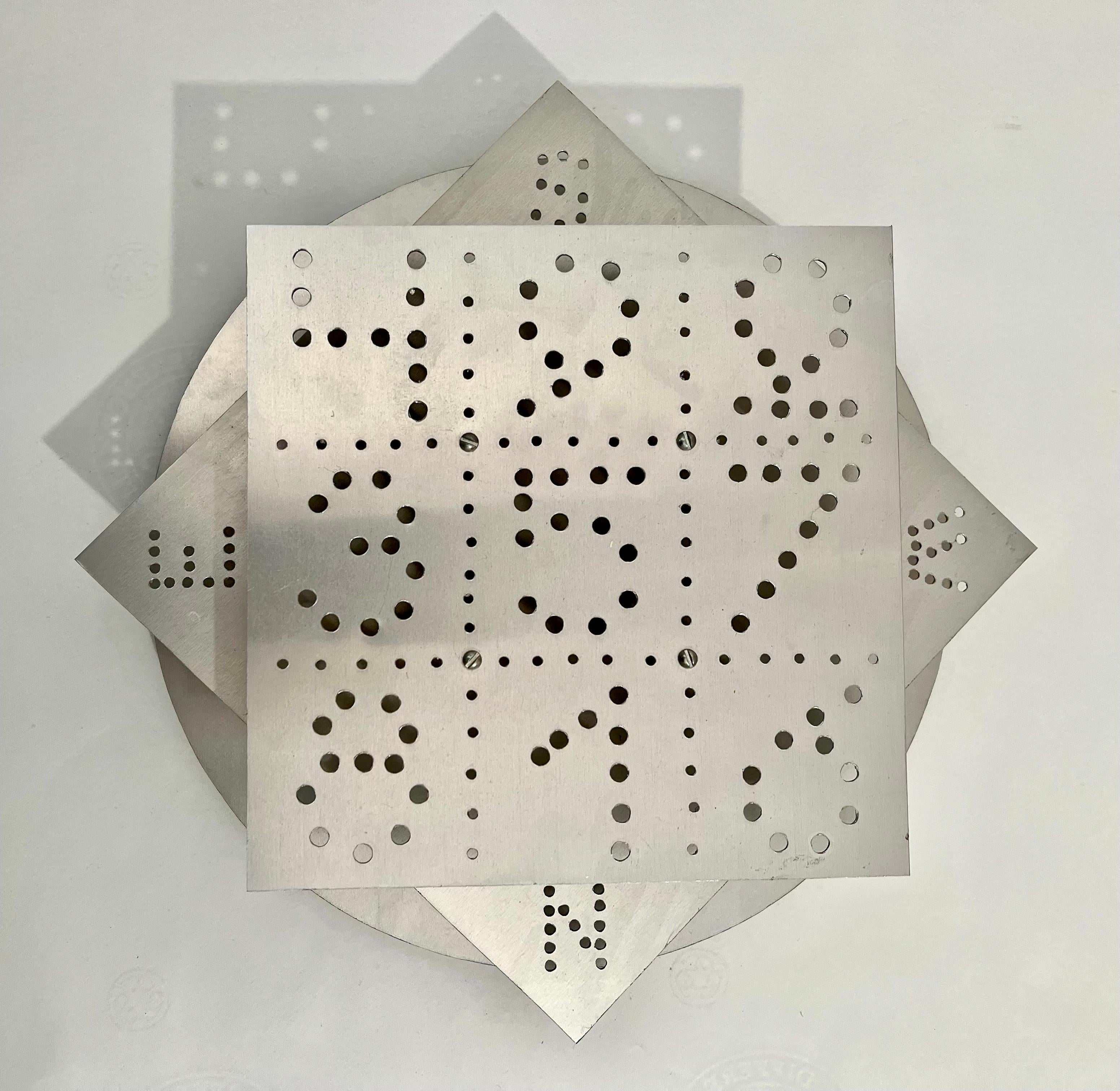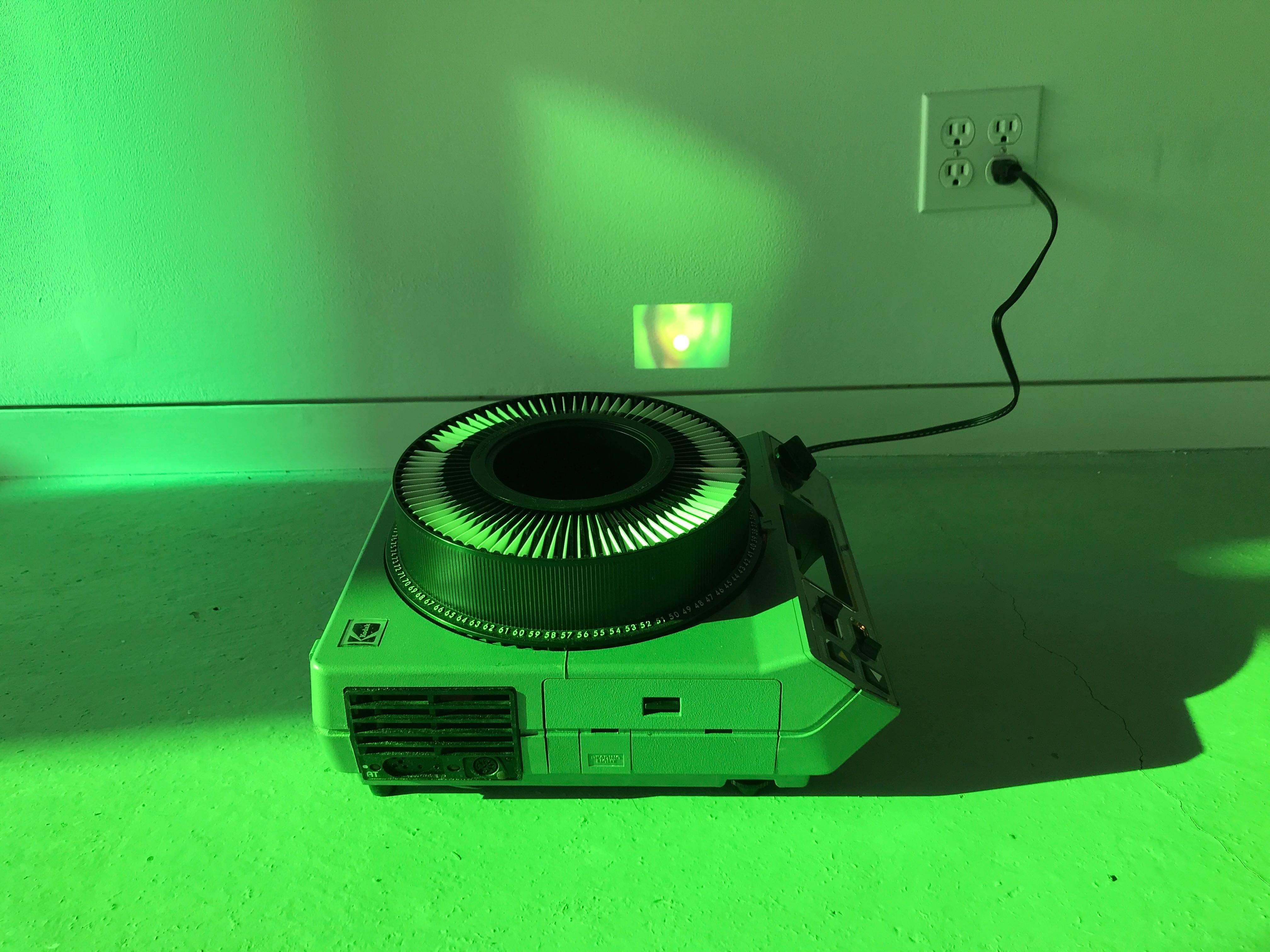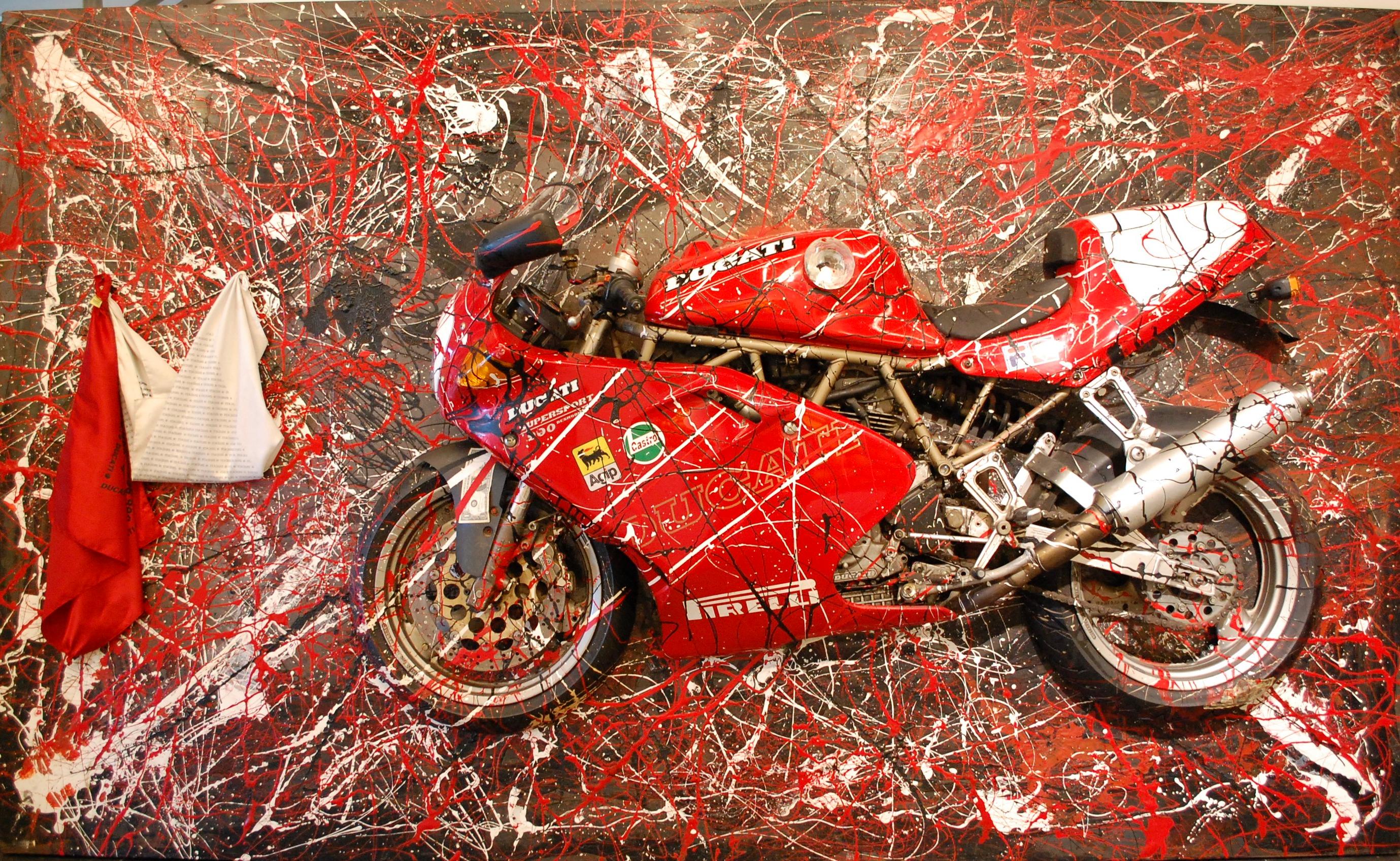Items Similar to Russian Samizdat Art Conceptual Photo Sculpture Assemblage Gerlovin & Gerlovina
Want more images or videos?
Request additional images or videos from the seller
Rimma Gerlovina & Valeriy GerlovinRussian Samizdat Art Conceptual Photo Sculpture Assemblage Gerlovin & Gerlovina1987-1994
1987-1994
About the Item
Rimma Gerlovina and Valeriy Gerlovin
Clock, 1987-94
Aluminum sculpture, mixed media and c-print photograph construction, c-print, felt tip marker
13 h × 13 w × 4 d in (30 × 30 × 6 cm)
Rimma Gerlovina and Valeriy Gerlovin were founding members of the underground conceptual movement Samizdat in the Soviet Union, described in their book Russian Samizdat Art. Based on a play of paradoxes, their work is rich with philosophic and mythological implications, reflected in their writing as well. Their book Concepts was published in Russia in 2012. The work by Rimma Gerlovina and Valeriy Gerlovin is emphatically contemporary. The artist couple were part of the Moscow Conceptualists, their performance Costumes, from 1977, deepened their ongoing work with linguistic semiotic systems and their own bodies. Considering the context in which Gerlovina and Gerlovin made their work—that of political restrictions on public life, of unfreedom, and censorship—their collaborative togetherness must also be read as a space of possibility for political community and resistance. Rimma Gerlovina’s hair is featured prominently in the art of the Gerlovins as a constructing element of the body. Used for the linear drawings her braids transmit transpersonal waves reminiscent of an aura of live filaments. Long loose hairs function as threads of life; streaming in abundance, they allude to Aphrodisiac vitality and Samsonian strength. On the other hand, they are the haircloth worn during mourning and penitence. In New York they continued to make sculptural objects, and their photographic projects grew into an extended series called Photoglyphs. In their photographs, they use their own faces to explore the nature of thought and what lies beyond it. Since coming to the United States in 1980, they had many exhibitions in galleries and museums including the Art Institute of Chicago. The New Orleans Museum of Art launched a retrospective of their photography, which traveled to fifteen cities. Group exhibitions include the Venice Biennale, the Guggenheim Museum, New York, Smithsonian National Museum of American Art, Washington D.C., Bonn Kunsthalle, Germany, Tokyo Metropolitan Museum of Photography, State Tretyakov Gallery, Moscow, and others.
Samizdat or “self-published” began in the Soviet Union, and Samizdat art consists mainly of books and magazines published and distributed by the artists who made them. Samizdat art has sources in the innovative books and magazines turned out by the early 20th century Russian avant-garde—artists and writers like Olga Rozanova, Vladimir Mayakovsky, El Lissitzky, and Alexander Rodchenko.
Artists as varied as Alexander Archipenko, Leon Bakst, Marc Chagall, Naum Gabo, Alexandra Exter have all been associated with the movement. Later Samizdat examples include the poster portraits of Lenin and Stalin, both 1982, by the now New York–based Vagrich Bakhchanyan, a leading Samizdat personality whose career spans the development of the medium. Victor Tupitsyn, collages, Lev Nussberg Correspondence of K.S. Malevich (1878–1935) to L.V. Nussberg (1937–1998), 1981, texts and drawings made to appear as if by Malevich—the ultimate homage from the Russian avant-garde of the late 20th century to that of the early. Komar and Melamid, Valentin Goroshko and Elisabeth Clark, Alexander Kosolapov, Lev Rubinshtein, and Anatoly Ur. They were prominent members of the Post Soviet Avant Garde a group that included Ilya Kabakov, Vitaly Komar and Alexander Melamid, Grisha Bruskin, Leonid Sokov, Alexander Kosolapov and Erik Bulatov. Books featuring their works: Art on the Edge and Over by Linda Weintraub; Reflections in a Glass Eye (ICP and Bulfinch Press); Face, The New Photographic Portrait (Thames & Hudson); Moscow Conceptualism in Context (Prestel); Serpenti in Art (Bulgari); also art history college books, such as Understanding Art and Foundations of Art and Design by Lois Fichner-Rathus (Cengage), and others.
Their works have appeared on the covers of The New York Times Magazine; Zoom; The Sciences; The Buddhist Review Tricycle. In the Millennium Issue on art, The New York Times Magazine gave them a spread. (Excerpt from publications)
Museum collections include The Art Institute of Chicago; The Guggenheim Museum, NYC; The Getty Research Institute, Los Angeles; International Center of Photography, NYC; Centre Pompidou, Paris (cubes) (Mirror Game) ; Tate Modern, London; The Museum of Fine Arts, Houston; Cincinnati Art Museum; Denver Art Museum; Nasher Museum at Duke University, NC; the Polaroid Photograph collection, Yale University Art Gallery, New Haven, CT; The Scottsdale Museum of Contemporary Art, AZ; Ackland Museum of Art, NC; Zimmerli Art Museum at Rutgers University, NJ; Museo d'Arte Moderna di Trento e Rovereto, Italy; National Gallery of Australia, Canberra; The State Tretyakov Gallery, Moscow; Museum Moderner Kunst Ludwig, Vienna, and others. Their work has also been sold by leading auction houses, including Sotheby’s, Christie’s, and Phillip’s.
- Creator:Rimma Gerlovina & Valeriy Gerlovin (Russian, American)
- Creation Year:1987-1994
- Dimensions:Height: 12.5 in (31.75 cm)Width: 12.5 in (31.75 cm)Depth: 3 in (7.62 cm)
- Medium:
- Movement & Style:
- Period:
- Condition:aluminum shows minor wear, some light oxidation and a few faint abrasions scattered throughout, typical with age and materials. Overall, works present well.
- Gallery Location:Surfside, FL
- Reference Number:1stDibs: LU38211480342
About the Seller
4.9
Platinum Seller
These expertly vetted sellers are 1stDibs' most experienced sellers and are rated highest by our customers.
Established in 1995
1stDibs seller since 2014
1,550 sales on 1stDibs
Typical response time: 1 hour
- ShippingRetrieving quote...Ships From: Surfside, FL
- Return PolicyA return for this item may be initiated within 3 days of delivery.
More From This SellerView All
- Russian Samizdat Art Conceptual Compass Sculpture Assemblage Gerlovin, GerlovinaLocated in Surfside, FLRimma Gerlovina and Valeriy Gerlovin Compass, 1988 Aluminum sculpture, mixed media and c-print photograph construction, c-print, felt tip marker 12.5 h × 12.5w × 4 d in (30 × 30 × 6 cm) Rimma Gerlovina and Valeriy Gerlovin were founding members of the underground conceptual movement Samizdat in the Soviet Union, described in their book Russian Samizdat Art. Based on a play of paradoxes, their work is rich with philosophic and mythological implications, reflected in their writing as well. Their book Concepts was published in Russia in 2012. The work by Rimma Gerlovina and Valeriy Gerlovin is emphatically contemporary. The artist couple were part of the Moscow Conceptualists, their performance Costumes, from 1977, deepened their ongoing work with linguistic semiotic systems and their own bodies. Considering the context in which Gerlovina and Gerlovin made their work—that of political restrictions on public life, of unfreedom, and censorship—their collaborative togetherness must also be read as a space of possibility for political community and resistance. Rimma Gerlovina’s hair is featured prominently in the art of the Gerlovins as a constructing element of the body. Used for the linear drawings her braids transmit transpersonal waves reminiscent of an aura of live filaments. Long loose hairs function as threads of life; streaming in abundance, they allude to Aphrodisiac vitality and Samsonian strength. On the other hand, they are the haircloth worn during mourning and penitence. In New York they continued to make sculptural objects, and their photographic projects grew into an extended series called Photoglyphs. In their photographs, they use their own faces to explore the nature of thought and what lies beyond it. Since coming to the United States in 1980, they had many exhibitions in galleries and museums including the Art Institute of Chicago. The New Orleans Museum of Art launched a retrospective of their photography, which traveled to fifteen cities. Group exhibitions include the Venice Biennale, the Guggenheim Museum, New York, Smithsonian National Museum of American Art, Washington D.C., Bonn Kunsthalle, Germany, Tokyo Metropolitan Museum of Photography, State Tretyakov Gallery, Moscow, and others. Samizdat or “self-published” began in the Soviet Union, and Samizdat art consists mainly of books and magazines published and distributed by the artists who made them. Samizdat art has sources in the innovative books and magazines turned out by the early 20th century Russian avant-garde—artists and writers like Olga Rozanova, Vladimir Mayakovsky, El Lissitzky, and Alexander Rodchenko. Artists as varied as Alexander Archipenko, Leon Bakst, Marc Chagall, Naum Gabo, Alexandra Exter...Category
1980s Conceptual Figurative Photography
MaterialsMetal
- El CasoBy Christian BoltanskiLocated in Surfside, FLChristian Boltanski, El Caso, Parkett., Zürich. 1989 in the collection of the MOMA Museum of Modern Art NYC Miniature booklet with 17 photographs, 2 x 3 1/8” (5 x 8 x 0,6 cm) ring bound with perspex covers and printed title Ed. 80/XX, signed and numbered (this one is not signed or numbered and might be an artist proof) Guilty, Not Guilty. Themes central to Boltanski’s oeuvre find devastating expression in this tiny piece of pocket pornography containing images of brutal murder re-photographed by the artist from the Spanish detective magazine El Caso. [Ref. Bob Calle - Christian Boltanski Artist's Books 1969-2007, p.60]. Artists' book featuring 17 b/w photographs held together with two metal rings: "Luxury edition of a booklet with real glossy photographs, small enough to be hidden behind the hand... It pictures the bodies of victims of violent crime. By showing these photographs of half-naked corpses, bought nearer by close-up shots, the artist transforms the viewer into a voyeur who virtually becomes a sadistic partner in the crime." -- from Catalogue: Books, Printed Matter, Ephemera 1966-1991. references "Livres" by Christian Boltanski. Paris / Köln / Frankfurt, France / Germany : AFAA / Jennifer Flay / Walther König / Portikus, 1991. No. 69 in "Christian Boltanski : Catalogue: Books, Printed Matter, Ephemera, 1966-1991" by Christian Boltanski, Jennifer Flay, Günter Metken. Köln / Frankfurt, Germany : Verlag der Buchhandlung Walther König / Portikus, 1992, pp. 184 - 185. "Christian Boltanski : Artist's Books 1969 - 2007" by Christian Boltanski, Bob Calle. Paris, France : Éditions 591, 2008, pp. 60. Quote “There is in the work of the artist something of the high priest and something of the charlatan...Category
1980s Conceptual Figurative Photography
MaterialsPhotographic Paper
- MIxed Media Conceptual Art Sculpture Drawing Human Rights Welded IronBy Francoise ScheinLocated in Surfside, FLThis is a large sculpture and also includes an artist custom framed silkscreen with extensive handwork titled Line of Time, pencil signed and inscribed, presented in heavy metal and wooden frame (framed piece 24.5 x 30 in., sculpture piece is about 94 X 11 inches) Francoise Schein is a visual artist, trained as an architect - urban planner; She also teaches art at the ESAM Higher School of Arts and Media in Caen in Normandy . She is the founder of the INSCRIRE Association. In 2016, she was elected member of the Royal Academy of Sciences, Arts and Fine Arts of Belgium. Group Exhibitions Spain: 2016, The "5Contemporary" Paris gallery presented a group show at the Museum of Contemporary Art of Genalguacil, Spain. The show included important artists such as Françoise Schein, Mimouni and Pedro Castrortega. Born in Brussels , Françoise Schein left Belgium after studying architecture at the higher institute of architecture of the French community - La Cambre where she wrote her thesis on fundamental rights, then studied urban design at the Columbia University in the City of New York . She lived 11 years in New York where she begins a work on cartography territories. Subway map Floating on NY Sidewalk is his first monumental urban sculpture located at 110 Greene Street in SoHo (1985). At that time her works are abstract landscapes of cities, made up of networks, lines, trajectories, territories, founding texts and stories. They are constructed of very diverse materials and light. Returning back to Europe in 1989, she continues to work on what she calls her drawings-laboratories while beginning to integrate works in cities on civic themes, the main ones: at the Concorde metro station in Paris in 1991 and then in Brussels, Saint-Gilles , in 1992, these two projects took her to Lisbon in 1993 where she lived for five years and produced two monumental works (in azulejos) for the city of Lisbon at Parque metro station ( 1994) and another for the city of Stockholm at the Universitetet station (1998). She continues to travel to cities where she builds successively projects in Haifa , on the facade of the Beth Hagefen Jewish-Arab Cultural Center with Michel Butor (1994). Then she lives in Berlin where she builds the Westhafen station (2000) which takes her to Bremen to make her first human rights park, Rhododendronpark (2002). In 2005, she made the monumental Time Zone Clock in Coventry in 2005. Since 1999, she has also settled in Rio de Janeiro and initiated participatory artistic projects with the underprivileged population of the favelas . Since then, with the help of a locally trained team, many projects have been carried out, including one in Copacabana and more than 20 in different favelas (from 1999 to 2016). These works transformed the Rio workshop into sustainable development for the people who invested it. In Sao Paulo, since 2009, Françoise Schein has produced a monumental work with the participation of 1000 young people from the favela schools at Luz subway station. Her work is monumental recalling the works of Christo, Maria Dompe, Christian Boltanski, Anish Kapoor, Ai Wei Wei...Category
Late 20th Century Conceptual Abstract Sculptures
MaterialsIron
- Alkyd Enamel Oil Painting Half A Thought Cut Panel Wall Hanging Modern SculptureBy Peter WegnerLocated in Surfside, FLOil-based alkyd enamel on plywood panel with cuts. this is a cut plywood wall relief sculpture with paint on it. This has an architectural quality to it. Peter Wegner (born 1963) i...Category
21st Century and Contemporary Conceptual Abstract Paintings
MaterialsEnamel
- Gentleman, Marble and Travertine Conceptual SculptureBy Maria DompeLocated in Surfside, FLMARIA DOMPE, (Italian, b. 1958), Gentleman Sculpture, marble and travertine, 1995, height: 20 in. One of a pair, (Gentleman and Lady) being sold separately. Maria Dompe was born in ...Category
Late 20th Century Conceptual Abstract Sculptures
MaterialsTravertine, Marble
- Lady, Marble and Fabric Conceptual Abstract Sculpture Maria DompeBy Maria DompeLocated in Surfside, FLMARIA DOMPE, (Italian, b. 1958), Lady Sculpture, marble and fabric, 1995, height: 14 in. One of a pair, (Lady and Gentleman) being sold separately. Maria Dompe was born in Fermo on ...Category
Late 20th Century Conceptual Abstract Sculptures
MaterialsMarble
You May Also Like
- Jo Yarrington, Ghost girls_Slide Carousel, 2018, Photographic Film, Found ObjectBy Jo YarringtonLocated in Darien, CTRadioluminescence is the phenomenon by which light is produced in a material by bombardment with ionizing radiation and can be used as a low-level light source for night illumination of instruments or signage or other applications where light must be produced for long periods without external energy sources. Radioluminescent paint used to be used for clock hands and instrument dials...Category
2010s Conceptual Figurative Photography
MaterialsPhotographic Film, Found Objects
- Chimera BadBy Niki SingletonLocated in Los Angeles, CAAcrylic, oil, paper collage, car side mirror, branches, chimes, rag, clock radio (Instructions: Press “on” button on side of radio to turn on. Tune to suitable station) A pa...Category
21st Century and Contemporary Conceptual Abstract Sculptures
MaterialsAcrylic, Mirror, Mixed Media, Oil, Rag Paper
- Sculpture, Cinder Blocks For my FatherBy Alberto Montaño MasonLocated in Cuernavaca, MorelosAsh and lead blocks. Piece made of 3 blocks Exhibited at the International Art Fair, Zona Maco 2019 in Mexico City. Exhibited at Mana Contemporary at Jersey City, New Jersey in 201...Category
21st Century and Contemporary Conceptual Abstract Sculptures
MaterialsMetal
- HeirloomBy Nancy LarrewLocated in Santa Monica, CAWood, mirrors, wire, plastic, LED lights. Artist statement: "Behind the doors of this cabinet/tower is an infinity mirror and a DNA double helix branded with the word “trauma.” The...Category
21st Century and Contemporary Conceptual Abstract Sculptures
MaterialsWire
- The Fast The Furious & The Nothing DucatiLocated in Lake Worth Beach, FLThe Fast The Furious & The Nothing : Real Racing Ducati 900 motorcycle Artist signed, title on the back. Federico Brondi Zumino (UMA) is an Italian artist, born in Genoa on March 24th, 1972. At the age of five he took his first music lessons in guitar and piano. Federico received his first painting classes from hi mother, Laura De Micheli, the Genoes painter. Upon the age of eleven he began to draw and paint. At the age of 18 he obtained his high school diploma from the Nicolo Barbino artistic High School in Genoa with exemplary marks. At the age of 19 he devoted himself to the study of piano for many years becoming an excellent composer. At age 21 he attended La Linguistica Academia Delle Belle Arti in Genoa, whose president at the time was the artist Raimondo Sirotti...Category
2010s Conceptual Abstract Paintings
MaterialsSteel
- Merda d'Artista - Merde d'Artiste - Artist's ShitBy Piero ManzoniLocated in New York, NYPiero Manzoni Merda d'Artista - Merde d'Artiste - Artist's Shit, 2013 Sealed tin can in special offset lithograph paper and shrink wrapped sealed with a fingerprint The artist's sign...Category
2010s Conceptual Figurative Sculptures
MaterialsMetal
Recently Viewed
View AllMore Ways To Browse
Found Photos Vintage
Vintage House Photo
Retro Art Auction
Vintage Concept Art
Art Metal Construction
Photo Auctions
Italian Poster Art Exhibition
Los Angeles Vintage Photo
Los Angeles Vintage Photos
Vintage Los Angeles Photos
Vintage Los Angeles Photo
Russian Book
Russia Book
Vintage Eye Photo
Russian Photo
Russia Photos
Russian Art Books
Braided Art





